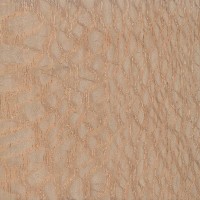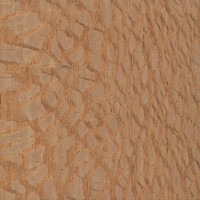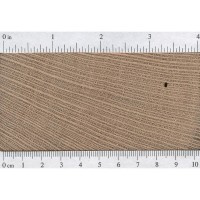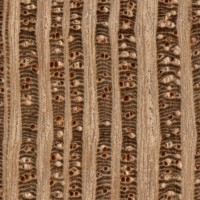 |
Common Name(s): Lacewood, Brazilian Lacewood, South American Lacewood Scientific Name: Panopsis spp. (P. rubescens and P. sessilifolia) Distribution: Tropical South America Tree Size: 30-50 ft (9-15 m) tall, 2-3 ft (.6-1.0 m) trunk diameter Average Dried Weight: 36.2 lbs/ft3 (580 kg/m3) Specific Gravity (Basic, 12% MC): .48, .58 Janka Hardness: 840 lbf (3,740 N) Modulus of Rupture: No data available Elastic Modulus: No data available Crushing Strength: No data available Shrinkage:No data available |
Color/Appearance: Has a very conspicuous flecking that gives this wood its namesake. The wood itself is a reddish brown with grey or light brown rays, which result in a lace pattern when quartersawn. Like other woods that exhibit the strongest figure in quartersawn pieces, (such as Sycamore), Lacewood has the most pronounced figure and displays the largest flecks when perfectly quartersawn; this is due to the wood’s wide medullary rays, whose layout can be seen the clearest when looking at the endgrain.
Grain/Texture: Has a fairly coarse and uneven texture due to the difference in densities between the regular wood tissue and the rays. The grain is usually straight.
Endgrain: Diffuse-porous; small to medium pores in tangential rows; solitary and tangential multiples of 2-3; deposits in heartwood occasionally present; growth rings indistinct; very wide rays easily visible without lens; parenchyma banded, diffuse-in-aggregates.
Rot Resistance: Lacewood is rated as non-durable and is also susceptible to insect attack.
Workability: Overall a fairly easy wood to work with, taking glues, stains, and finishes well; though there may be some difficulty in planing, with tearout occurring. Some species of lacewood can also have a moderate blunting effect on cutting edges.
Odor: No characteristic odor.
Allergies/Toxicity: Although there have been no adverse health effects reported for Lacewood in the Panopsis genus, several other genera in the Proteaceae family have been reported to cause eye and skin irritation. See the articles Wood Allergies and Toxicity and Wood Dust Safety for more information.
Pricing/Availability: Prices for Lacewood vary depending upon the specific species, but tend to be medium to high for an imported wood.
Sustainability: This wood species is not listed in the CITES Appendices or on the IUCN Red List of Threatened Species.
Common Uses: Veneer, cabinetry, fine furniture, musical instruments (guitars), and turned objects.
Comments: The name “Lacewood” is used very loosely and can be applied (and misapplied) to a number of different wood species. In its vaguest sense, the term “lacewood” is used to describe any wood that displays figuring that resembles lace. Attempts to identify a specific board macroscopically may be difficult.
Two Australian species, Northern Silky Oak (Cardwellia sublimis), and Southern Silky Oak (Grevillea robusta) can both look very similar, and are sometimes sold as Australian Lacewood. Additionally, Leopardwood (Roupala spp.) looks similar, but tends to be slightly darker brown, and is significantly heavier.
Proteaceae family:








Stumbled across this at Singh Hardwoods in Rockaway Beach. Their stock was all flat cut, so the face has the spotted leopard print look rather than the spidery lace effect of the quartersawn boards. It was a bit of a challenge to work with chisels — not insurmountable, but chopping through the hard medullary rays required very frequent re honing of my edges, so make sure you have a strop handy if you work this with hand tools. No allergic reactions to report. Beautiful result for the book cradle I built.
A flamed Brazilian Lacewood used to make a guitar top.
I have carved several fish in ropala lacewood as the grain mimics the scales of a fish. The fins and tails etc I carve in lime and stick it on. Lime is particularly good as you can carve as thin as you need to get a likeness. JRH Woodcarving.
I have had the same experience with Lacewood as Mr Rushing (above). Finally my son and I emptied the shop again, vacuumed the walls, washed and vacuumed the floor and all tools etc.,etc, and finally SPRAYED THE ENTIRE INTERIOR OF THE SHOP— WALLS,FLOOR CEILING WITH VARATHANE WATER BASED SATIN VARNISH.(COVERING THE LARGE POWER TOOLS) THAT ENDED THE NIGHTMARE AND MY SHOP IS BACK TO NORMAL. The fine sawdust is now sealed under the varnish and out of harms way. Charles Fisher
Omg, I’m dealing with that right now. My shed is covered with dust from lacewood. That dust is terrible and I currently have a rash from it.
Eric,
The stuff I worked with is DEFINITELY in the Janka 2200 end of the spectrum! (and might also explain why I did not have an allergic reaction :-)
Great to know! Thanks!
Tom
Tom,
I think the term “lacewood” is used very loosely, and I’ve worked with woods that are lacewood-like in appearance, but are very dense, and I’ve also worked with woods that look almost the same but are quite light and soft.
To me, if it’s heavier than most domestic hardwoods like maple or walnut, and it’s a darker reddish brown, then I’d consider it Leopardwood, regardless of what name it was sold under.
I’ve machined Lacewood for some boxes I’ve made without any adverse reaction to it, but I’m grateful for those who’ve highlighted the potential allergy problem. I’ll be more diligent about dust collection and protecting my skin in the future. My main interest, however, is in the ‘estimated’ hardness number. To me, Lacewood seems incredibly stiffer and harder than any of the usual hardwoods I use (Cherry, Walnut, Hard Maple) all of which have higher Janka numbers than this estimated value. It would be nice if we could find an actual measured value for this wood. By the way, I love… Read more »
I turn pens with lacewood all the time. I have never had an adverse reaction to it. It is nowhere near as bad as cocobolo or any of the other rosewoods. Apparently only the sensitive people post here.
If you’re allergic to something you’re allergic to it, it often has nothing to do with how ‘sensitive’ you are in general. Lacewood is one of the only woods that I’ve ever had a reaction to, and that includes Purpleheart, Cocobolo, Rosewoods, Wenge, and pretty much every other wood known to man.
While that’s technically true, a lot of those woods you list are also known sensitizers. That is, you can start off not having any sort of reaction at all, and then all of the sudden, out of the blue, you can have an allergic reaction (sometimes very strong). The wood sensitized you. I’ve heard many stories of this happening with people with Cocobolo.
I have also had a terrible reaction to this wood. Within 3 days of machining a project my ears, eyes, and inside of my forearms began to break out. Within 6 days I was covered with a horrible rash and I wound up having to make a trip to the doctor to get a prednisone injection. Not sure how bad the contamination is in the shop but I picked up a tyvek suit and threw out my dust collector bags and vacuumed and wiped the place down. I’ll probably mop and wipe everything down with isopropal alcohol just to be… Read more »
I manufacture tools and build custom furiture. Lacewood is a prime wood used in the tools I produce and the furniture I build for “high end” customers. I have been using this material for over 20 years and have had no negative experiences with it. I love it and my customers continue to specify it for their custom items. I must be blessed to not be sensitive to this material.
See our products at – https://www.swantoolusa.com
Had the same experience as Andrew Gemmell. Horrible allergic reaction that recurs if exposed to even the tiniest particle. Even after a two day cleaning session in “space suits” my shop is still infected with this stuff. I literally cannot use my 900 sq. ft. shop now. About the only thing I can do is burn the thing to the ground. Beautiful wood, but not worth the risk. Trust me on this one.
Have had severe reaction to Lacewood. Rash, itchyness, swelling of eyes and throat. Instructed by pharmacist to seek immeadite medical attention.Was prescribed antihistimine to deal with reaction. Rash continued for 2-3 weeks.Swelling lasted 1-2 weeks. More pronounced on sensitive areas. Reaction was a result of milling dry lumber and inhaling fine dust particles. Have known others to have same reaction. Highly toxic! Miserable.